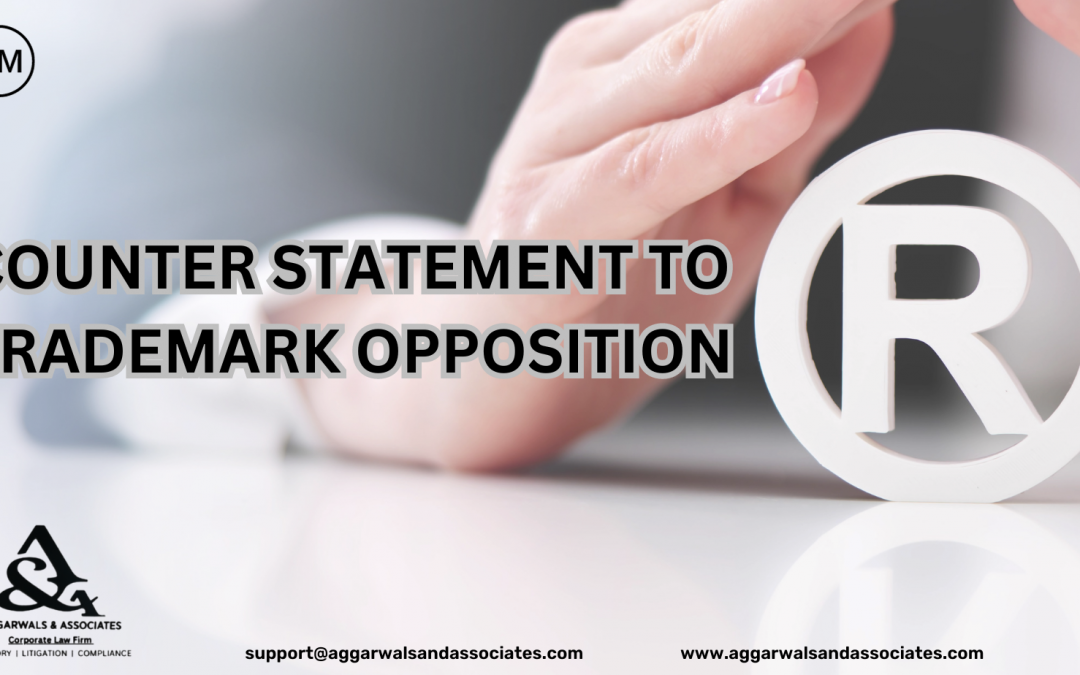What is a counter statement in trademark registration?
After the application for the registration of the trademark has been accepted by the registrar, he is under the duty to put the application in public through advertisement. The application remains in the public for an aggregate of four months. In the given time if any person raises any objection to the trademark, he can apply for oppositions to the registrar. The registrar then sends the opposition raised by the person to the applicant (defendant) of the Trademark. The defendant has two months to reply to such opposition. This reply by the applicant (defendant) against the opposition raised is the counter statement.
What is the purpose of a counterstatement?
Counter statement is the reply filed by the applicant (defendant) of the Trademark to the person who has raised an opposition against the registration of the Trademark of the defendant. The main purpose of counterstatement is to rebut the allegations or any claims etc. made by the opponent against the registration of said trademark.
What are the grounds of defense in Trademark infringement?
Various grounds of defense against trademark infringement are:
- Fair Usage of the Trademark:
The accused needs to prove that he has the consent of the proprietor of the trademark for using it.
- Prior use of the trademark:
The accused must prove that he has been using the trademark for a longer period even before the person who had registered the trademark in his name.
- The proprietor of the trademark has not used the trademark for a long time:
If the proprietor of the trademark has not used the trademark for a long time.
- The acquiescence of the Proprietor to the adverse usage of the trademark by others:
If the accused person is using the trademark and the proprietor has the knowledge of such usage by the accused but still, does not raise any objection for a long time.
- Dissimilarity between two trademarks:
The accused should prove that the two trademarks are dissimilar.
What are the essentials of a counter-statement?
A counter statement should be in detail i.e., it should deal with all the claims or questions raised by the opponent in the opposition application in detail.
To start with, complete details relating to the registration of a trademark should be contained in the counterstatement, for example, the Origin of the trademark (history of the idea behind it if any), Goods and services, or type of business for which the trademark would be used if registered, the factual background of the case, allegations in the opposition application, etc.
Then, arguments in favor of the defendant’s case should be mentioned clearly, supported by evidence (if any). After that, what type of relief is being sought by the defendant against the opponent?
At last, the counterstatement should be verified by the applicant (defendant) stating the contents of the document to be true to his knowledge. The verification can be done by a duly authorized agent of the defendant. In such a case, the counterstatement should be accompanied by the POA (Power of Attorney) in favor of such agent.
Other information that shall be stated in the counterstatement includes the application number of the trademark, ID, and address of the defendant.
Legal Remedies against infringement of trademark
The Trademark Act of 1999 offers both civil and criminal remedies against the infringement of the trademark.
Under civil remedies, a person can claim an injunction (temporary/permanent), damages, and rendition of accounts of profits.
Under criminal remedy, the plaintiff has to file an FIR with the police. The punishment under criminal remedy is imprisonment for a period of six months to two years or a fine which may range between Rs. 50,000 to 2 lakhs.
Grounds for which criminal action could be taken:
- Falsification of the trademark
- Falsely applying the trademark
- Selling or possessing goods having falsely applied for a trademark
What is the process for trademark opposition?
Following is the process for trademark opposition:
- Notice of opposition: Notice of opposition against the trademark should be given within 3 months (extendable to an additional one month) from the date of publication of such trademark in public.
- Counter statement: After receiving the notice of opposition, the defendant files a reply (counter statement) against the opposition.
- Submission of evidence by both parties: Both parties are given specific time for submission of evidence in support of their claim.
- Hearing: The registrar gives notice to both parties for a hearing. The parties can know the time of the hearing.
- Registration/Rejection of the trademark application: After giving a reasonable opportunity of being heard to both parties, the registrar may pass the order for registration or rejection of the trademark application.
- Appeal: ‘The Tribunals Reforms Act, 2021’ abolished the IPAB (Intellectual Property Appellate Board). The functions of the erstwhile IPAB now vest with the country’s commercial courts and High Courts.
Conclusion:
This article examines the complex legal landscape of trademark opponents in India, exploring the various ways in which they can be analyzed and analyzed. It provides an in-depth look at the legal implications of trademarking, as well as the potential benefits and drawbacks of doing so.
Write-up By: Hanuman Bishnoi, Legal Intern at Aggarwals & Associates


